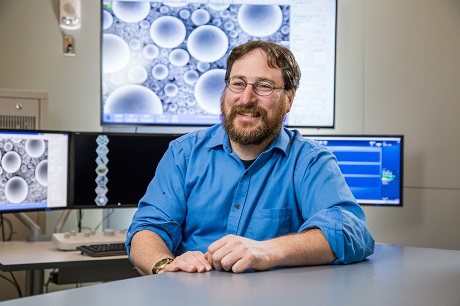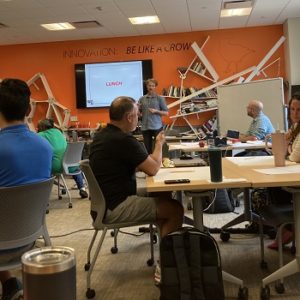Q&A with Craig B. Arnold — Vice Dean for Innovation at Princeton University
By Alaina O’Regan, Office of the Dean for Research, Princeton University
Ed Note: This article was prepared by Princeton University. We bring it to you so you can get to know Craig B. Arnold who will have a large impact on how innovation and tech transfer is handled at Princeton.
“I approach the role of Vice Dean for Innovation through the lens of three key objectives: breaking barriers, building bridges, and benefiting society.”
Craig B. Arnold, the Susan Dod Brown Professor of Mechanical and Aerospace Engineering and director of the Princeton Institute of Materials, looks forward to igniting the spirit of innovation as he begins his new role as Princeton University’s vice dean for innovation.
As a multi-time entrepreneur, Arnold brings valuable skill and experience to the position.
“I’ve gone through the whole cycle of developing the intellectual property, commercializing it, starting a company, selling products and ultimately, selling the company.” Arnold said. “I’m excited to share my experience and help others to realize their goals and aspirations.”
Arnold has been a leader in this community for years, having served as director of the Princeton Institute of Materials since 2015. In this interview, Arnold discusses his plans to break barriers, build bridges, and create a network of support for all who strive towards innovation on and off campus.
Q: Why does innovation matter to you?
A: I think that any innovation comes down to a problem, seeing something that you say, ‘I wish this were better,’ or ‘I wish this problem could be fixed,’ or ‘I wish I could help make a difference.’ We start thinking about new ways to tackle challenges. We bring new creativity to the problem. And I think that’s something that really drives almost everybody to want to innovate.
Q: What is needed to push innovation forward?
A: Developing technology is one side of it. But it’s also developing the ideas, sharing the ideas, building a community to study something, or building new collaborations across different types of communities. This can mean collaboration across different disciplines, between universities and industry, between universities and the government, or international types of collaborations to solve global challenges. All of those things, I think, drive us to make the world a better place.
Q: Why is it important to emphasize diversity and inclusion within innovation?
A: Innovation comes from everywhere. It doesn’t belong to any one group of people, or to one particular discipline. I think that we have to challenge ourselves and question our assumptions, and by being inclusive of all people, we can truly inspire and drive innovation.
Q: What will you do as one of your first tasks on the job?
A: We have to give people the opportunity to share their ideas. And that means, on my side, doing a lot of listening. But also I hope to challenge people to push themselves further, to inspire and support people, and to work to give members of our community whatever they need to remove stumbling blocks. That’s my job, to remove barriers.
Q: What are your short-term goals in serving this role?
A: One of my short term goals is to make sure it’s very clear for everyone to identify what the opportunities are on this campus and how to access them. There are a lot of people on this campus who not only want to listen to you, but they want to help. Learning that those opportunities are there, knowing that people are going to support you, that’s what allows you to really grow.
Q: What about long-term goals?
A: In the long term, I think the goal is to create an environment where people feel empowered. We want to make it so that the people who want to start a company have the ability to do that, and the people who want to bring together new types of ideas to think about problems have the ability to do that as well. We want to make sure that we’re meeting the needs of our community in the broadest sense, and that includes entrepreneurship, but it also includes research.
Q: What do you think makes a university innovative?
A: Innovation doesn’t just happen in one place. It happens everywhere on this campus, in all corners. And this is something that really excites me about it. Innovation is more than just starting a company. I think someone who works in a cafeteria who figures out how to get produce from 50 miles away instead of 200 miles away is impacting climate change in a significant way. So I think that people all have different challenges, and most importantly, they have different needs to facilitate.
Q: What are you excited about?
I’m particularly excited about three things. Firstly, we need to look at big problems. We need to challenge ourselves. We need to push ourselves. We have to expand our horizons to think more creatively, to think collaboratively to solve the challenges that each of us come up with. Secondly, I am eager to help build the bridges, and connect not just the people here on campus — build the bridges across the disciplines, humanities, social sciences, engineering and sciences — but also bridges to the outside, look at how we interact with industry, how we spin out our technologies and ideas. Thirdly, I am inspired by the idea of how our innovations can benefit society.
Q: What do you look forward to most for the future of innovation at Princeton?
A: Princeton really is very special. We have tremendous students, faculty and staff. One of the things I’m looking forward to is highlighting just how special they are when it comes to their creativity in the way that they’re solving problems. They are making the world a better place. We talk about Princeton, ‘In the Nation’s Service and the Service of Humanity’. It’s not just words, it’s actions. It’s exciting to me to be able to see some of that firsthand.


